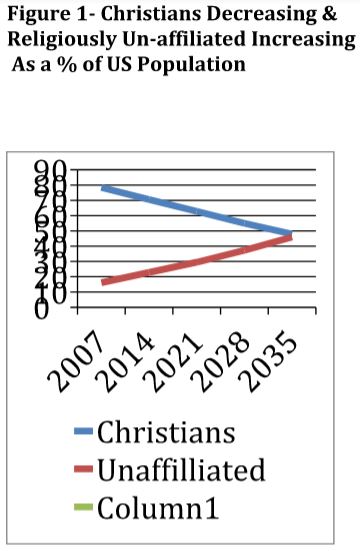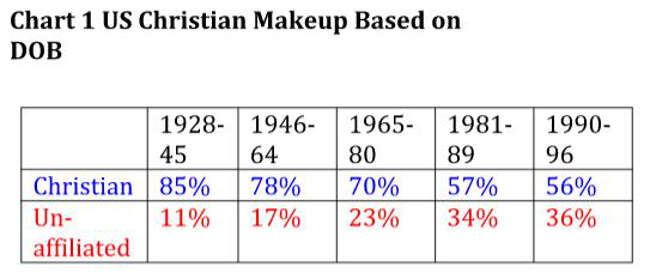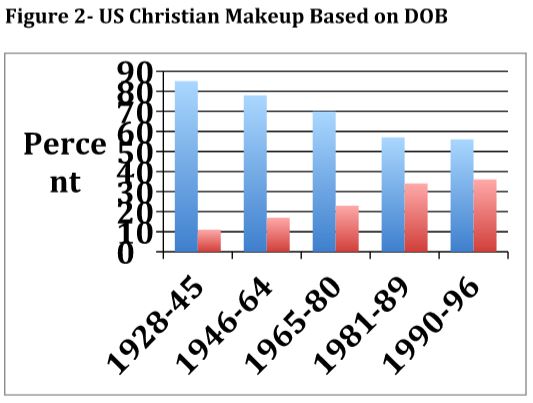By Lee Southard, Ph.D.
Original January 15, 2018. Revised March 20, 2018
Let me state the obvious. What we do today in terms of training and equipping young people and their parents in the Christian faith will help determine whether they will remain dedicated followers of Christ and remain in the church. The results of that effort will also help determine their eternal future, their effectiveness as churchgoers and as Christian citizens of the United States of America.
However, the obvious is not the urgent!
Trend data from reliable survey organizations are disturbing and American Christians should be alarmed. Actually the nation should be alarmed. A cultural and faith war has been waging in this country since it’s founding but in the last 50 years survey data reveals that this war is beginning to point to a conclusion. It is not a conclusion we as Christians will like.
We are in a war and most of us do not know it but this is a war we have been losing!
Surveys by the Barna Group, Pew Research and Lifeway Research over the last 20 years have produced corroborating data showing that teenage churchgoers will drop out of church attendance and many of those will never return. Taking data from these studies To Know With Certainty calculated that the percentage of teens that will never return would be around 32% of all who have dropped out of church attendance. 1
To make this more alarming this data is about Evangelical Christian teens. In other words every year we are losing one-third of what are supposed to be Christian teens with the strongest basic beliefs.
Our young people are the future of Christianity. If as adults they are not increasing as a percent of the US population this does not bode well for Christianity in America or for America.
In the Religious Landscape Study by Pew Research2 in 2014 (n=35,000) it was reported that as a percentage of the US population Christians constituted 78.4%(2007), 70.6% (2014) and are projected to decrease to 62.8 % in 2021. In contrast religiously non-affiliated are increasing. The non-affiliated were reported as 16.1% (2007), 22.8% (2014) and are projected to rise to 29.5% in 2021. Extrapolation of this data graphically indicates a point in the future when Christians in America will be less than the religiously non-affiliated, assuming the trends remain the same. (Figure 1)

According to the extrapolation that date arrives around 17 years from now in 2035 when the infants of today will be graduating high school.
How do we conclude that this trend could be the result of losing young people? Consider more data from the Pew Research Religious Landscape study. (Chart 1)

The study showed that the Christian makeup of the US population is very different based on when one is born. Christians have decreased to 36% among those born in the 1990-96 period and who would be 22 to 28 years old today. Their grandparents, those today who are 73-90 years old are 85% Christian, a significant disparity between today’s young adults and their grandparents. The religiously un-affiliated are found at only 11% among the grandparents and 36% among the grand children. The extrapolation of the date of birth data agrees with the data when Christianity as a percentage of the population will be a minority. (Figure 2)

This trend of an increase in the religiously non-affiliated and decrease in those expressing Christianity is over every succeeding generation since 1928.
It is not that something is decidedly wrong but has been decidedly wrong for some time.
Assuming the trend continues where more of our young adults do not prefer Christianity will not bode well for them as older adults, for the nation and for the church. As adults they are more likely to be in positions of leadership and influence.
According to the data that date arrives around 17 years from now in 2035 when the infants of today will be graduating high school. If not prepared radically different than what we have been doing they will only add to the problem.
We like to blame colleges and universities for the adverse effects on Christian students but in fact these students were inadequately prepared to defend and contend for the faith before arrival at college.
Unequipped students are sitting ducks for new worldviews.
Consider the Cooperative Institutional Research Program (CIRP) Survey of Incoming College Students3 conducted by UCLA from 1966-2016 (Figure 3). This large sampling (137,000 in 2016) of incoming college students shows an alarming trend that the number of college students with no religious affiliation has tripled in the last 30 years. Over the same period the number attending religious services dropped from 85% to 69%. (Data not shown) In summary this data supports the premise that any vulnerability at the college level regarding religious affiliation is present at entry. The battle is lost before our young people graduate high school.
Figure 3- Religious Preference of College and University Students (1966-2016) Based on Cooperative Institutional Research Program (CIRP) Survey of Incoming College Students 3

N=137,000 first time students at 184 US colleges and universities in 2016
When the graph in Figure 3 is extrapolated it shows that around 2035 the number of students in the nation’s colleges and universities expressing no religious affiliation will exceed those that do.
The reasons for this decline of Christianity revolves around one simple truth: Our kids are not being adequately prepared and equipped to withstand the onslaught of adverse information that serves to erode their faith.
The same is true of too many adults from prior generations and these trends cut across all Christian denominations.
The church must not stand idle knowing that the seeds of its demise have been sown and knowing why. Based on the Parable of the Sower the church must find the fertile ground and if not there develop it and maintain its fertility.
To do this a battle plan including a plan of execution is required beginning with church kids corresponding to K-12. Running parallel would be a similar plan to address adults, parents and grandparents. Any solution will require the family and the church.
At its very heart these plans should equally emphasize Christian education from an apologetics view, enhance knowledge of scripture and appeal to the student’s intellect.
Christian education should be conducted with the same accountability as secular education.
This trend constitutes a significant problem for the church and for the United States of America whose very existence is dependent on Christian values and morals being an essential part of our cultural fabric. These played a large part in making us a great nation. Our Founding Fathers emphasized this repeatedly.
The dilution of these morals and values is guaranteed to decrease as the cultural influence of Christianity decreases. The country has many unresolved issues both foreign and domestic but none are as important as the lessening of the Christian influence in American culture. This trend is a major National Security Issue for America because as we have seen in Europe and other places once lost you cannot get it back.
Only the problem has been stated here. Solutions will not be easy but the problem must be addressed with the attitude that it is solvable. What is clear is that the only institution that can address the problem with any strength of resources to make an impact is the church. To be successful it must have the commitment of its congregation, its education staff from K-12, plus parents and students and involve discipleship and evangelism to round out an apologetics and scripture based education.
It is time for a new Great Awakening?
References:
- G. Lee Southard, To Know With Certainty, xx, West Bow Press, Bloomington Indiana, (2017). Visit www.toknowwithcertainty.com.
- Pew Research Center, Americas Changing Religious Landscape, http://www.pewforum.org/2015/05/12/americas-changing-religious-landscape/
- Allen Downey, Scientific American, https://blogs.scientificamerican.com/observations/college-freshmen-are-less-religious-than-ever/ May 25, 2017




